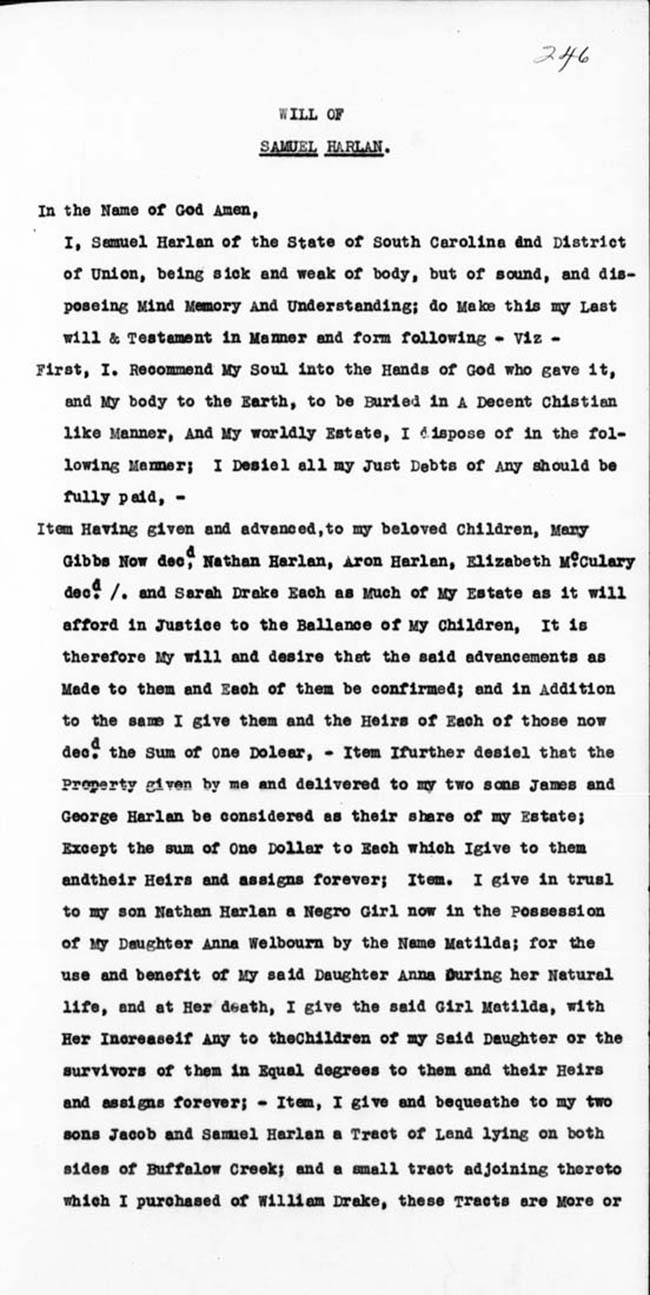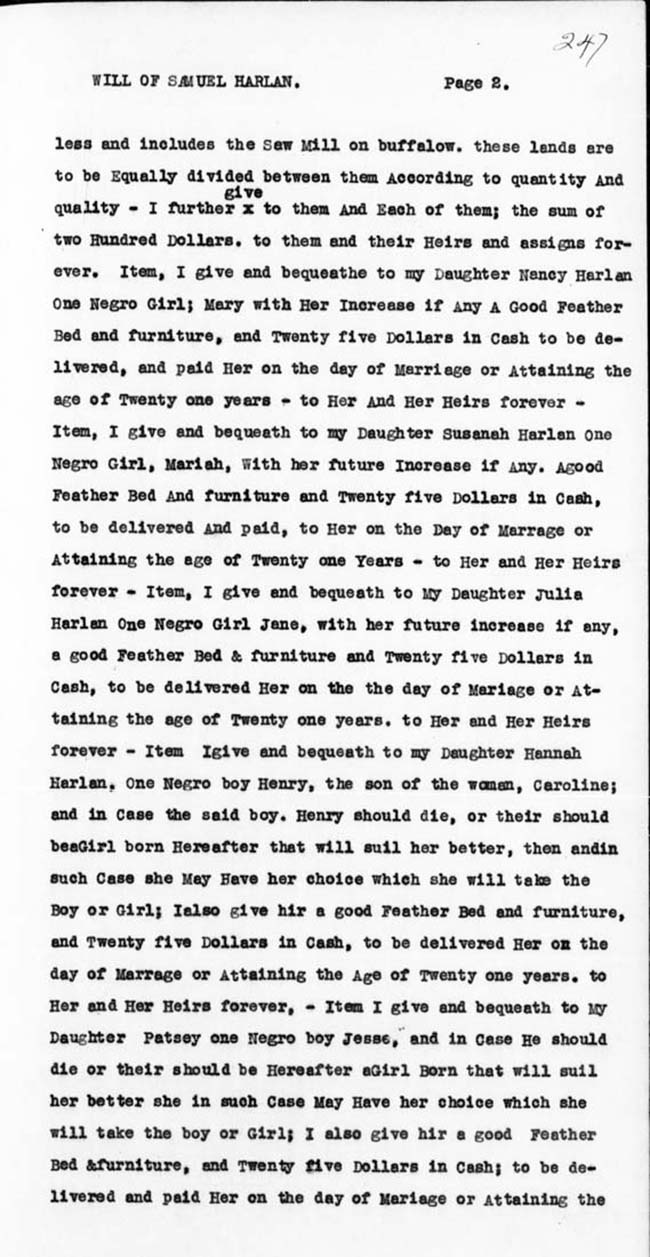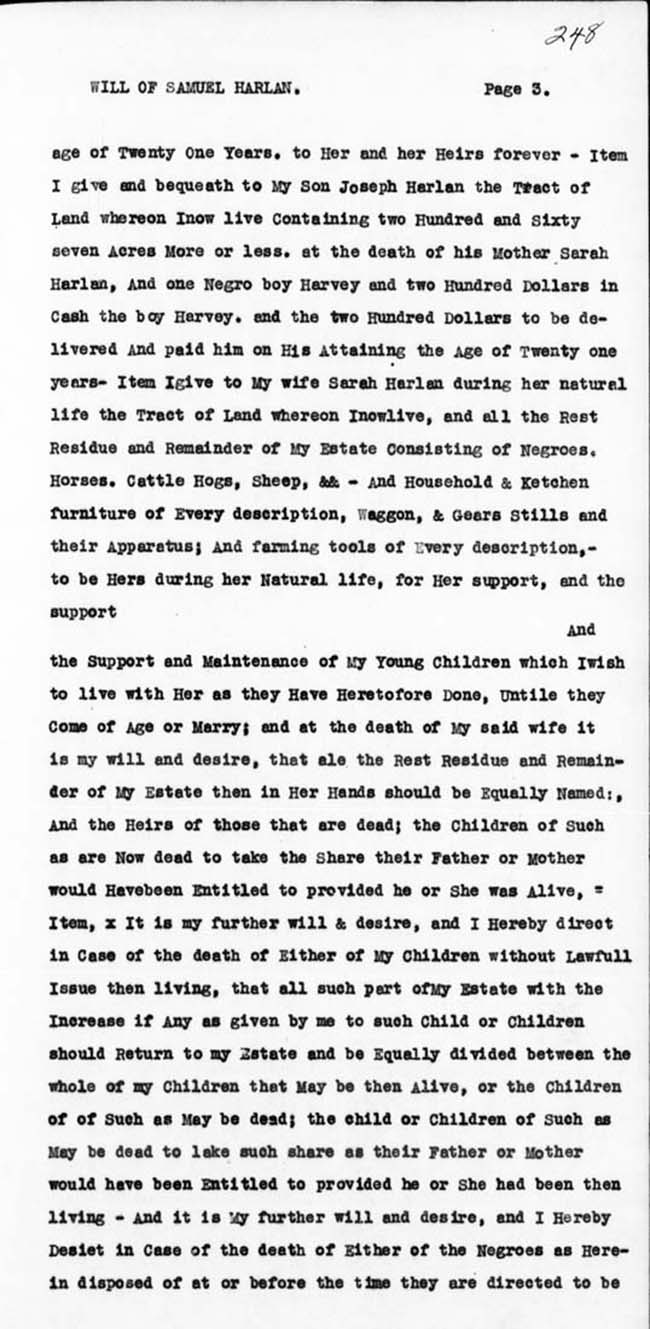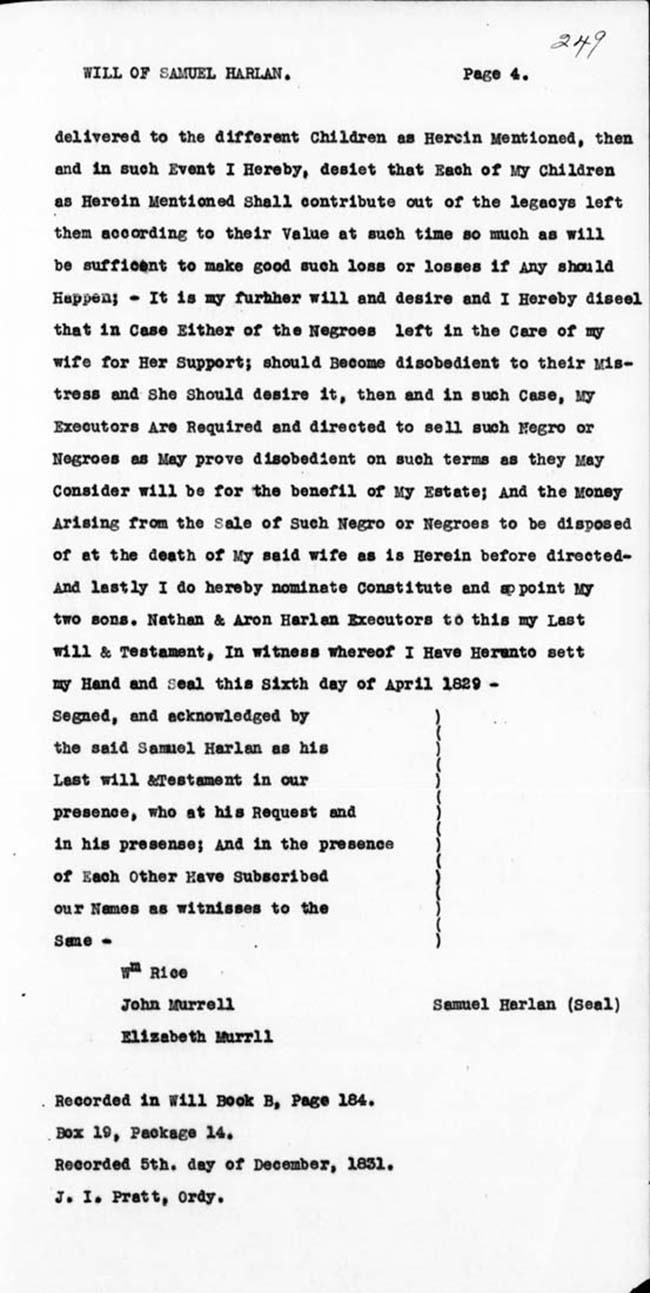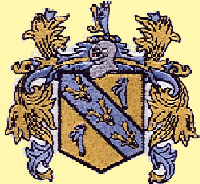|
The Trek to
California
Please visit the Harlan Web
Sites
for more History - Stories - & Genealogy
http://www.harlanfamily.org/
http://www.techcrafters.net/PAGEN/Chester/
Numbers in parentheses are from Alpheus
Harlan's "History and Genealogy of the Harlan Family". All
rights reserved by the author.
It would appear from the subject of this
paper that the author was indulging in some form of ancestor worship. The
purpose, hopefully however, is neither chauvinistic nor merely
antiquarian; I believe my forebearers amply demonstrate certain key
concepts operating on the frontier in general, and California in
particular. The technique I intend to use is only quasi-scholarly; many
superfluous details will be omitted, and some of the minor factual
conflicts between sources will be cited only as it seems appropriate. In
addition, I will rely heavily on the only work written by one involved,
Jacob Wright Harlan's California from '46 to '88, a book charmingly
exaggerated and inaccurate. What follows, then, is a patchwork of
questionable dates and places, fanciful and real accounts, all sewn
together with supposition and hope.
The first Harlan, a Quaker named George
(3), arrived in this country in 1687. For the next one hundred years, four
generations of that name lived around the Quaker settlements in the East,
particularly Chester County, Pennsylvania. There were conflicts between
Harlans and the other Friends; for instance, one was publicly denounced
for "vanity" in erecting an elaborate tombstone on his wife's
grave, another for marrying a non-Quaker woman. Yet the Harlans seemed, by
and large, content with their home, until after the Revolutionary War,
when one George Harlan (218) who served as a "wagon boy" in that
conflict, moved his family to Central Kentucky, now Lincoln County, on the
Barren River. Among his children were four boys—Elijah (854), William
(850), Samuel (851) and George (852)—and it is with this last named
Harlan that the course of the 19th Century frontier expansion is most
evident.
In 1806, when George (852) was four, the
family moved north into Ohio, settling near the present site of Dayton, In
1815 his father died and the family moved again, west to Wayne County,
eastern Indiana. The territory was, at this time, very sparsely settled.
Jacob Harlan recounts how George (852) married Elizabeth Duncan, from
Pennsylvania, in 1823. Eight years later, he moved his family still
further west, to Berrien County, in the extreme southwestern corner of
Michigan, around Niles. By 1845 George was the family chief over a sizable
number of people; he had six children of his own: Rebecca (2990), Mary
(2991), Joel (2992), Nancy (2994), Elisha (2995), and Jacob (2996). In
1845 the two older girls were married to two brothers, John and Ira
VanGordon, and the youngest child, Jacob was only six. George's brothers,
William (850) and Samuel (851) had died, leaving some of their children in
his care.
What could compel an apparently
successful wheat farmer to venture far beyond all American settlement,
across half a forbidding continent, in 1845? Partially it was Langsford
Hastings' book on Oregon and California, for George (852) may have known
Hastings before he left Michigan for the West. Primarily, however, the
reason for this drastic step into the unknown was the obvious urge to
travel, to push the frontier back, evident in Harlan's earlier moves. So
it was that in October, 1845, George Harlan set out with eleven wagons and
an indeterminable number of people. I have ascertained the following
members of the train at the beginning of the trip: George, his wife,
Elizabeth, and their six children; his mother-in-law, Mrs. Duncan, near
ninety; his two sons-in-law, the VanGordons; Sarah (2983), Jacob W. (2984)
and Malinda (2985), Samuel's children; George W. (2977), William's son,
Sarah's first cousin and husband, married in 1845; possibly William
Harlan's widow and son, William, Jr. ( 2979). As the train moved south
through Illinois and Missouri, they picked up more followers and not a
little shocked disbelief at their intention. An Irishman, when told their
destination, thought they were joking and became belligerent. Others
mistook them for Mormons, once more migrating. They were held up for a
week when Elisha (2995) was run over by one of the wagons, but he
recovered quickly. Around St. Clair, Illinois, probably, the train picked
up the Fowler party of at least six and later, in Missouri, a man named
Clark who had lost his crops and farms.
Since the Fowler Family later becomes
important in our narrative, it would be well to trace their interesting
history briefly. The father, Henry, began as an architect or master
carpenter in Albany, New York, moved then to Illinois, and finally went to
Oregon in 1843 with his two sons. Soon they were in California building
for General Vallejo and obtaining property on the present site of
Calistoga. He sent his son, William, back to bring the rest of the family:
his wife, two unmarried daughters, Catherine Fowler Hargrave and her
husband. When they joined the Harlan train, William Fowler was apparently
the only one who knew anything of their destination.
That winter the party stayed in
Lexington, Missouri, making some money by transporting Sac and Fox Indians
for the government to the Kansas line. Some of the younger men worked in
the hemp fields to help defray expenses. The next spring they gathered in
Independence with about five hundred other wagons to begin the trek west,
under the leadership of ex-Governor Boggs of Missouri.
There are several conflicting accounts
of the Harlans' trip west. The following outline of events is the
generally accepted version: the large group of wagons moved west, the
Donners and Harlans undoubtedly traveling part way together. They
stretched out along the trail to the South Platte and Fort Laramie.
Travelers from the west brought word that Langsford Hastings himself would
meet California-bound trains at Fort Bridger to guide them along a new
short-cut which would save at least three hundred miles over the old trail
to Fort Hall. Probably at the Sublette cut-off, which by-passed Fort
Bridger, the various trains parted, only a few going south to take up
Hastings' offer. Whether one assumes that Hastings was seeking personal
aggrandizement, or, as Bancroft asserts, was sincere in his efforts to
help, it is apparent that the famous guide knew very little about the
trail over which he intended to take the wagons; it has even been
suggested (c.f.Pidney's For Fear We Shall Perish) that Hastings was acting
as agent for Bridger and Vasquez whose business was suffering because of
the Sublette cut-off.
Three major parties went through Fort
Bridger in 1846 following Hastings' new trail: a pack train led by Bryant
and guided by Hastings' partner, Hudspeth; the Harlan-Young Train, with 66
wagons, which left Bridger about July 23 with Hastings; and the Donner
Party which started around July 31 with instructions to follow the wagon
tracks and watch for notes from Hastings. A famous note, however, was
already waiting for the Donners, as well as the Harlans before them, a
note from Bryant sent back to the fort, urging all who followed to avoid
Hastings' new route. Bridger and Vasquez found it expedient for business
not to deliver this information. The Harlan-Young train, the first wagon
over this trail, reached the head of Weber Canyon in the Wasatch Mountains
of Utah and ran into a stone wall, literally. Pigney's words describe it
best: "Reed told the story of the Harlan-Young ordeal in dramatic
detail. It was a miracle the wagons had scraped through at all. Bad
places? Everything was bad. For miles the canyon was so narrow there was
hardly enough room for a team between the river and the cliffs. At one
point the party had made no more than a mile and a half in a week. At
other places the shoulders thrusting into the gorge were so steep the
wagons had to be lifted over by windlass and rope. One wagon had crashed
75 feet into the river."
Hastings left a note at the entrance to
Weber for the Donners, urging them not to follow, to ride ahead for
directions to a better route. In their wait for Reed's return, the Donners
lost still more time. The Harlan-Young train, meanwhile, struck out across
the desert south of Salt Lake. It was further than Hastings had
anticipated, necessitating their unyoking the oxen and returning for
water. It was during this stretch that William Hargrave died, William
Fowler lost seven yoke of oxen for his two wagons, and most of the
livestock of the train perished. The party finally hit the Humbolt River
far behind the Boggs train, which had followed the longer route, but
several weeks ahead now of the Donners. The Harlan-Young wagons reached
Johnson's Rancho over the Sierras on October 25, 1846, the day of the
first snow, the last train to cross the mountains that winter.
We must now turn, for supplementary
information, to the account of Jacob Wright Harlan (2984), a fascinating
blend of Horatio Alger, California tall tales and a morality tract. Jacob
was only eighteen during the trip and was apparently dying of consumption.
He accompanied the Harlans because of his Uncle George's kindness to him
and because of a dream wherein he saw a great valley, an earthly paradise,
where all his troubles and ills would be cured. After some initial
reflections on his early tribulations with a harsh stepmother and a brutal
uncle, Elijah, Jacob recounts with gusto and prejudice his trip west.
Jacob had little love for the Mormons, observing "when they have felt
safe in doing so they have been ready to act in hostility to the
Gentiles." (Jacob Harlan, California from '46 to '88) Indeed, he
claims that had it not been for his people's efforts and the Gold Rush,
California would certainly have become a Mormon empire. He deplores the
injustice of the slave trade in Missouri and treatment of the Indians
throughout the country.
Hijinks marked the first half of the
trip west when the younger members played a practical joke on one Inman, a
criminal from Indiana masquerading as a preacher. Inman was not amused and
took a shot at Jacob who would have killed him on the spot had not George
interceded. Inman, over Jacob's objections for a fair fight, was voted out
of the train. Later one of the VanGordon boys sold Bill Williams, the
famous old trapper, a faulty gun which exploded and seriously wounded the
old mountain man. Buffalo and grass were plentiful and the Indians
friendly, up to Fort Bridger.
According to the author, the Donners and
Harlans left Bridger together. There is no mention of any Young party. At
Weber Canyon, Donner and Reid turned back to find a better route to the
south. Jacob blames their future disaster on their decision not to follow
Hastings' directions through Weber, although Jacob later remarks that
Hastings had no idea where he was going. Once the Harlans reach the
Humbolt River, the narrative picks up. Running low on supplies, George
Harlan sends Jacob and one Tom Smith ahead to Sutter's Fort for food and
fresh animals. The two boys narrowly escape Indian marauders, overtake
Boggs who sells them some food and commends their daring. They leave the
food for their party and strike out across the Sierras over Donner's Pass.
Jacob recognizes the Sacramento Valley as the land of his dreams which
would bring him wealth and health.
Sutter sells them the necessary supplies
and sends them to a rancher, Cordua, near Marysville for cattle, oxen and
horses. Although Smith deserts him to join Fremont's army, Jacob, with the
help of two Indians, recrosses the Sierras, meeting Stanton and Pike from
the Donner party, now about a hundred miles behind the Harlans. When Jacob
rejoins his train on the Truckee, George weeps and tells the entire
assembly they owe their lives to the boy. With fresh animals, the wagons
make it across the mountains before the snow.
If this account seems inaccurate and
romanticized, it should be remembered that Harlan wrote it forty-two years
later at the urging of Bancroft, after a full life, several fortunes and
many disappointments. Time tends to blur facts and glorify routine
actions. There is no other version, however, so we must accept the story
of the "Boy Wonder of the Humbolt." It is true that this account
is remarkably sympathetic and often accurate in its assessment of people.
Keeseburg, the vilified survivor of the Donner disaster, Jacob found to be
"eccentric" and "liable to mental derangement" but
much maligned by his detractors. He shows little prejudice toward the
Mexicans or Indians of California, praising Don Castro of San Leandro and
damning the wily land lawyers who take his land. Fremont he praises
cautiously for exacting from himself the sacrifices he asked of his men.
Even Hastings is forgiven and enlists Jacob at San Jose for Fremont.
While the rest of the family wintered at
Mission San Jose, Jacob left with the army to complete the conquest of
Southern California. The trip south was without any conflict, but with
hardship and excitement. Most of the horses were lost in the muddy
campaign; Totoy Pico, cousin of the commander in the South, was captured
and held as hostage; an Indian carrying a secret message north was shot as
a spy. Jacob was impressed by ranching techniques of the Californians,
particularly their horse breeding and oxen yoke construction. He remained
with Fremont at San Gabriel until April, 1847, primarily in case there was
trouble between his detachment and Kearney's force.
We can judge both the harshness of the
overland journey and the rather interesting social conditions of pre-Gold
Rush California from the official dates in the next four years. Young John
VanGordon and Elizabeth Harlan died soon after they reached San Jose; her
daughter, Rebecca (2990), died the next year and her little son, Jacob, in
1848. Mrs. Duncan, at 93, passed away in 1849 near Coloma, and George
himself died in the summer of 1850. Thus, the life. Most of the girls who
came across were soon married. In 1847 George (852) married the widow
Catherine Fowler Hargrave, and his nephew, Jacob (2984), married her
sister, Ann Fowler. At their marriage Governor Boggs "enjoined upon
us to act as good citizens and to have a big family and help people the
country which was in need of American population." Two years later,
Joel Harlan (2992) completed the interesting marital pattern by wedding
the third Fowler girl, Minerva, thus making his sister-in-law and
stepmother the same, and his stepbrother and sister, nieces and nephews.
Apparently the scarcity of suitable brides precluded any stigma in this
union: Joel made much fun about it, calculating what the relationship
would be, that he would be his father's brother-in-law. He said it would
take a Philadelphia lawyer to determine what the relationship of their
children might be.
From 1847 to 1852 Joel (2992), George W.
(2977), Jacob (2984) and until his death, the patriarch George (852)
operated pretty much as a family unit in a variety of enterprises. First
they cut redwood shingles and fence posts in the Oakland Hills for the
village of Yerba Buena. Then there was a small hotel, the Fremont, opened
in the wilds of Santa Clara by George W. and his cousin-wife, Sarah. The
livery stable Jacob and Joel operated in San Francisco until 1848 made a
great deal of money, enabling them to obtain $4,500 worth of supplies and
open the first general store in Coloma during March of 1848. After
refusing partnership with Sam Brannan, the Mormon, the Harlans really
began to strike it rich selling food and supplies to miners at what Jacob
confessed were very high prices but far lower than would later be charged:
$25 for a pair of boots, $16 for a pick, $8 for a bottle of whiskey. Their
biggest killing, $1,200 in a few hours, came from selling serapes made of
carpeting and coarse cloth to gold-laden Indians. In 1849 they sold their
store and few remaining goods to Langsford Hastings.
Their brief experience at gold mining
was also phenomenal: Joel got $1,450 in dust on the American River in one
day but lost his claim to jumpers. The next year George W. and Jacob made
a strike near Sonora but left because of Indian hostility. Despite their
successes in the diggings, land and farming remained the Harlans' chief
goal. Returning to San Francisco, Joel and Jacob started a dairy with
George's eight milk cows which had survived the trek. Their going price
for fresh milk was $4 a gallon. Jacob, also, in the speculative spirit of
the time, made an easy $2,500 selling a "worthless" lot on Bush
Street, so called because it was simply sand hills and greasewood bushes,
to Dr. Coit and two partners.
After an unsuccessful farming attempt
near Niles (perhaps named after their original home in Michigan), Jacob,
Joel and their families led a group of squatters onto a piece of rich land
at the mouth of San Lorenzo Creek which was being disputed by the Castros
and Estudillos. When Jacob, as leader of the squatters, refused to move at
the order of William H. Davis, the Estudillos' foreman, he was offered a
contract to plow 200 acres on the Estudillo rancho. He and Joel completed
this by January of 1852, made more money and put in their own crops. From
merely an acre of potatoes, which Jacob first thought the frost had
killed, he made over $1,250, selling his crop at 25 cents a pound. With
this money Jacob was able to pay Castro, whom he acknowledged as the
rightful owner, and then departed for his Indiana home.
Joel Harlan, with his money, purchased a
1,000 acre ranch in the Amador Valley around 1852. When the new county
line was drawn for Alameda, the Harlan house was used as a boundary
marker. In 1856 the family moved again to the Norris Tract at Danville.
Joel added to his holdings for a total of 1,800 acres, built a two-story
house, "El Nido", and was one of Contra Costa County's earliest
cattlemen. On his death in 1875, the control of the property, for some
reason never divided among his seven children, passed to his widow and
eldest son, Elisha C. Harlan. This gentleman added more acreage and
enlarged the house before his death in 1938. The land then passed into the
hands of Mrs. A. J. Geldermann of Danville and as of 1985, "El Nido"
was still standing.
Jacob Harlan, who sailed from San
Francisco in 1852 and reached New York via Panama, was a wealthy man. He
contrasted the two-cent charge on the Brooklyn Ferry with the $250 it had
cost to cross Knight's Ferry to reach Sonora. After he returned to Indiana
and wrung apologies from his relatives for their former harsh treatment of
him, he bought the old family homestead and presented it to his
stepmother. With his brother, George, and cousin, William, he set out
again for California with 306 head of cattle and horses. Again utilizing
the Salt Lake cut-off, he reached home with 189 head after an exciting
trip. After this final overland venture, Jacob's career continued to be
varied but less successful. He ran Slocum's Ferry near Stockton, raised
livestock in a number of places, lost much of his property in title
disputes and ended his life in an Old Soldiers' Home, destitute except for
his Army pension.
Elisha Harlan, the last subject of this
paper, grew to maturity in the frenzied atmosphere of California's Golden
Age. Like his older brother and cousin, he chose to seek his fortune from
the land. He married Lucy Hobaugh in 1871 at San Luis Obispo, and by 1875
he had established the Harlan Ranch, 25 miles south of Fresno, at
Riverdale. The ranch was later divided between Jerome, my great-uncle . .
. and Leroy, my grandfather. Dairying and beef cattle were their main
occupations until the advent of cotton, and the sale . . . of the ranch.
My father, Keith, could remember the cattle drives in the 1920s and early
'30s west across the barren West Side of the San Joaquin to summer
pasturage in the hills of the Coast Range.
What, then, is the significance of this
story? Perhaps it most clearly shows that American frontier development
was not an orderly, generation-by-generation progression from east to
west, but rather a kind of restlessness which drove individuals like
George Harlan from one wilderness to another, leaping ahead of civilized
security but always bringing with them a culture distinct from that they
invaded. The uniqueness and bonanza of California's mining frontier might
lure them for awhile to the easy money of the Gold Rush; but they reverted
to farming and ranching, for it was land, not gold, which had brought
them. Finally, I like to think how my great-grandfather must have felt, a
man who was run over by a covered wagon at eight and survived to see mail
delivered by airplane. If the changes witnessed by Jacob, Joel or Elisha
Harlan seemed bewildering to them, they at least knew their efforts were
an essential part of bringing those changes about.
—William K. Harlan, CA |
